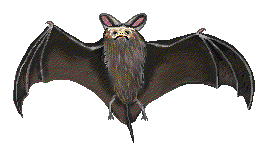Bats

Bats are in serious decline nearly everywhere. Worldwide, there are almost a thousand different kinds of bats which comprise nearly 1/4 of all mammal species. Of the 43 species living in the U.S. and Canada, nearly 40 percent are endangered or are candidates for such status The biology and ecology of bats is not well understood. Their nocturnal behavior, inaccesible breeding and roosting sites and migratory behavior have made them difficult to study. As a result, we know little of bat ecology or management needs on public lands. Despite a lack of knowledge, we do know that bats often use trees, cliffs, caves, human dwellings, natural waters and water developments, bridges and mine shafts in a variety of habitats. There are clearly opportunities to begin specific management actions to protect or enhance this diverse and threatened group of mammals.
Putting up a bat house is one of the more rewarding ways to help wild life. By providing bats with a roosting habitat, you also benefit by having fewer yard and garden pest like mosquitoes and ants. It may seem like just a drop in the bucket but we can over come chemical pest control and create a cleaner healther environment. Bat houses may be put up at any time of the year. They will more than likely be occupied in the first three to four weeks after they have been installed. Installing a bat house and exposing it to the rain and sun will darken the color even more increasing the chances of attracting bats just that much better.
![]()
Bats can consume up to 500 insects an hour, including mosquitoes (although I've read that mosquitoes make up only about 10% of their diet). The health hazard to humans is small, since very few bats actually carry rabies. Only ten people in thirty years have gotten rabies from a bat bite. The main hazard comes from bats roosting inside the house, which can be a source of histoplasmosis. However, in the wild, bat populations are declining, and natural roosting areas are being destroyed.
![]()
Plants that should be in a bat garden include:
Salvia - This has spikes of blooms in red, purple, salmon, lilac, white, blue, and pink, so take your pick.
Silene - This plant has 3" clusters of deep rose flowers
Phlox - Star-shaped flowers and needle-like leaves. The flowers can be blue, crimson, pink, white, and red.
Stock - This also has sturdy spikes of full, fragrant flowers which come in pink, white, and lavender, and there's also the Evening Stock from the night garden.
Cornflower - Also known as Bachelor's Buttons, these are fragrant, many-petaled, old-fashioned flowers in pink, blue, white and maroon.
Spearmint - A fragrant herb, which also has small white blooms.
Flowers that all bloom in the evening are Four o' Clocks, Moonflower, and Nicotania.
![]()
Don't be discouraged if you don't attract bats right away....sometimes it takes quite a bit of time before a bat population will establish itself in an area, but once they do, they usually return. (The chances of a bat house being occupied are increased if the house is hung by early April, and if there are already bats roosting nearby.)
![]()
Bat Facts
There are 950 species of bats. Two-thirds of these species are insect-eaters, with most of the remaining third eating fruit, nectar, and pollen. A very few species eat fish, or birds, small mammals, and reptiles, and three species feed on blood.
The largest bat, Pteropus vampyrus, has an average weight of 3 1/2 oz., and a wingspan of over 5 feet! The smallest bat, Craseonycteris thonglongyae, weighs less than a tenth of an oz., and has a wingspan of six inches.
A bat can consume up to one-half its weight in insects in one night, and might fly as far as 50 miles to get full.
![]()
![]()
 Wildflower
Seed For Sale
Wildflower
Seed For Sale